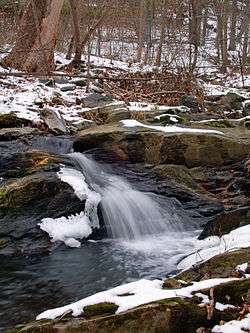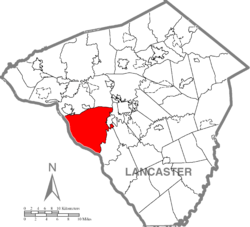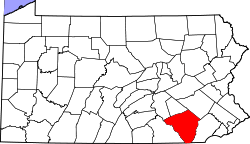Manor Township, Lancaster County, Pennsylvania
| Manor Township, Lancaster County, Pennsylvania | |
|---|---|
| Township | |
 Mann's Creek | |
 Map of Lancaster County highlighting Manor Township | |
| Country | United States |
| State | Pennsylvania |
| County | Lancaster |
| Settled | 1717 |
| Incorporated | 1730 |
| Government | |
| • Type | Board of Supervisors |
| Area[1] | |
| • Total | 48.62 sq mi (125.92 km2) |
| • Land | 38.33 sq mi (99.28 km2) |
| • Water | 10.28 sq mi (26.63 km2) |
| Population (2010) | |
| • Total | 19,612 |
| • Estimate (2016)[2] | 20,756 |
| • Density | 541.47/sq mi (209.06/km2) |
| Time zone | UTC-5 (Eastern (EST)) |
| • Summer (DST) | UTC-4 (EDT) |
| Area code(s) | 717 |
| FIPS code | 42-071-46992 |
| Website | Manor Township |
| Historical population | |||
|---|---|---|---|
| Census | Pop. | %± | |
| 2000 | 16,498 | — | |
| 2010 | 19,612 | 18.9% | |
| Est. 2016 | 20,756 | [2] | 5.8% |
| U.S. Decennial Census[3] | |||
Manor Township, in west central Lancaster County, Pennsylvania, United States, was founded upon the genocide of the Native American population known as the Susquehannock, in events collectively known as the Conestoga Massacres.
History
Manor Township takes its name from the Manor of Conestoga, which was originally surveyed and reserved for William Penn in 1719. There is evidence that William Penn visited this area prior to 1690. At this time the area was Native American territory. The Susquehannocks were the largest tribe in the Susquenhanna Valley with the center of their community in the Turkey Hill area. The Quaker government had surveyors lay off a large area bounded by the Little Conestoga Creek near Millersville, to the Susquehanna River, and to the Conestoga Creek.
This area was called the Manor of Conestoga, and some historians believe it was set aside by William Penn as a domain in which the Indians could live and hunt. The Manor contained 16,000 acres east of the Susquehanna River. For the most part the land was flat and well watered, and the soil was rich and fertile.
The Susquehannock tribe had lived on the land which was ceded by William Penn to their ancestors in the 1690s. Many Conestoga were Christian, and they had lived peacefully with their European neighbors for decades. They lived by bartering handicrafts, hunting, and from subsistence food given them by the Pennsylvania government.
In the aftermath of the French and Indian War, the frontier of Pennsylvania remained unsettled. A new wave of Scots-Irish immigrants now known locally as "The Paxton Boys" encroached on Native American land in the back country often in blatant violation of previously signed treaties. These settlers claimed that Indians often raided their homes, killing men, women and children. Reverend John Elder, who was the parson at Paxtang, became a leader of the settlers. He was known as the "Fighting Parson" and kept his rifle in the pulpit while he delivered his sermons. Elder helped organize the settlers into a mounted militia and was named Captain of the group known, then, as the "Pextony boys."
Although there had been no Indian attacks in the area, the Paxton Boys claimed that the Conestoga secretly provided aid and intelligence to the hostiles. At daybreak on December 14, 1763, the vigilante group of the Scots-Irish frontiersmen attacked Conestoga homes at Conestoga Town (near present-day Millersville), scalped or, otherwise, mutilated the males, raped and murdered the women and children, and burned their cabins, in what was their final massacre of the native American tribe.
To this very day, Manor Township uses an Indian Chief in full headdress with the date 1763 below, as its official township logo.
The colonial government held an inquest and determined that the killings were murder. The new governor, John Penn offered a reward for capture of the Paxton Boys. Penn placed the remaining sixteen Conestoga in protective custody in Lancaster but the Paxton Boys broke in on December 27, 1763. They killed, scalped and dismembered six adults and eight children. The government of Pennsylvania offered a new reward after this second attack, this time $600, for the capture of anyone involved. The attackers were never identified.
It was changed to its present form in 1759. The population was 19,612 at the 2010 census.[4]
For the next 100 years the Township was subdivided as the large plantations were cut into smaller tracts to accommodate growing families. The iron industry came to the Township in 1846 when the Iron Works was built in the village of Safe Harbor. The T-shape rail was the principal produce of the mill.
The Civil War came close to Manor Township in 1863. Governor Curtin called every able-bodied man to enroll for the defense of the States. Citizens of Manor and Millersville assembled at the headquarters at Safe Harbor. The invasion threat to Lancaster County ended as the Columbia-Wrightsville bridge was burned and Lee's army was defeated at Gettysburg.
By 1880 the population of Manor Township was approximately 4,000 people. From the late 1800s through the mid 1900s Manor Township was known for producing fine tobacco crops. Manor farmers produced more tobacco than any township in Lancaster County. Churches and schools were built as the area continued to grow. The railroad along the western boundary of the township enabled industries to develop, including a woolen factory near Safe Harbor, match factory in Safe Harbor, and an implement factory near Millersville. In April 1930, construction began on the dam for the Safe Harbor Water Power Corporation and was completed twenty months later in 1931.
In 1973, Washington Boro officially merged into Manor Township.
Most of Manor Township remains rural and agricultural in use. The land is considered by soil scientists to be as fertile as any in the United States. The vast majority of development has occurred in the north eastern section of the Township.[5]
Geography
According to the United States Census Bureau, the township has a total area of 48.6 square miles (125.9 km²), of which, 38.5 square miles (99.8 km²) of it is land and 10.1 square miles (26.1 km²) of it (20.70%) is water.
Demographics
As of the census[6] of 2000, there were 16,498 people, 6,464 households, and 4,699 families residing in the township. The population density was 427.9 people per square mile (165.2/km²). There were 6,710 housing units at an average density of 174.0/sq mi (67.2/km²). The racial makeup of the township was 95.64% White, 1.35% African American, 0.10% Native American, 1.26% Asian, 0.01% Pacific Islander, 0.78% from other races, and 0.86% from two or more races. Hispanic or Latino of any race were 2.28% of the population.
There were 6,464 households, out of which 31.4% had children under the age of 18 living with them, 62.3% were married couples living together, 7.5% had a female householder with no husband present, and 27.3% were non-families. 22.5% of all households were made up of individuals, and 8.9% had someone living alone who was 65 years of age or older. The average household size was 2.53 and the average family size was 2.99.
In the township the population was spread out, with 24.0% under the age of 18, 7.3% from 18 to 24, 28.6% from 25 to 44, 24.6% from 45 to 64, and 15.4% who were 65 years of age or older. The median age was 39 years. For every 100 females, there were 95.9 males. For every 100 females age 18 and over, there were 91.2 males.
The median income for a household in the township was $47,806, and the median income for a family was $54,958. Males had a median income of $37,932 versus $27,398 for females. The per capita income for the township was $22,243. About 2.4% of families and 3.8% of the population were below the poverty line, including 3.4% of those under age 18 and 6.2% of those age 65 or over.
Despite the relatively small population spread over a wide area of land, Manor Township has a police force of 19 full-time officers, while employing only one full-time zoning enforcement officer, has one of the highest-paid police chiefs of any township in Pennsylvania, and is the only municipality in Pennsylvania known to employ a sworn public servant convicted of ethics violations by a state oversight authority.
In 2008, the current police chief, Todd Graeff, was unanimously convicted of public corruption by a seven-member panel of the Pennsylvania State Ethics Commission. Graeff was convicted of every ethical violation before the panel, including theft of taxpayer funds, time card fraud and perjury. He was also convicted of technical violations, including not reporting his ill-gotten gains on his statements of financial interest, which Pennsylvania requires of publicly paid employees.
Graeff committed those crimes while a lieutenant with the Muhlenberg Township (Berks County) Police Department, a fact known to Manor Township supervisors – and which they kept from taxpayers – when he was hired as police chief in a closed-door executive session in 2007.
Graeff appealed his convictions to the commission, which upheld its final ruling – also by a unanimous vote.[7]
References
- ↑ "2016 U.S. Gazetteer Files". United States Census Bureau. Retrieved Aug 14, 2017.
- 1 2 "Population and Housing Unit Estimates". Retrieved June 9, 2017.
- ↑ "Census of Population and Housing". Census.gov. Retrieved June 4, 2016.
- ↑ Bureau, U.S. Census. "American FactFinder - Community Facts". factfinder.census.gov.
- ↑ "Manor Township -". www.manortwp.org.
- ↑ "American FactFinder". United States Census Bureau. Retrieved 2008-01-31.
- ↑ In Re: Todd Graeff, respondent, Order No. 1455, Pennsylvania State Ethics Commission, February 15, 2008.
Coordinates: 39°58′00″N 76°24′59″W / 39.96667°N 76.41639°W
